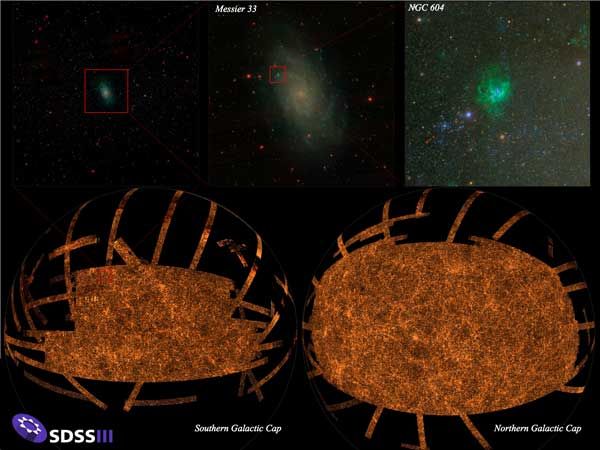Astronomers Unveil Largest-Ever Color Photo of the Sky

Scientists have released the largest digital color image of the sky ever made, and it's free to anyone who wants a look.
Researchers with the Sloan Digital Sky Survey-III (SDSS-III) unveiled the image today (Jan. 11) at the 217th meeting of the American Astronomical Society, in Seattle. They had assembled the picture over the last decade from millions of 2.8-megapixel images, creating a color image of more than a trillion pixels. [New image of the whole sky]
This terapixel image is so big and detailed that you'd need 500,000 high-definition TVs to view it at its full resolution, the researchers said.
"This image provides opportunities for many new scientific discoveries in the years to come," Bob Nichol, of the University of Portsmouth, said in a statement.
Best view of the sky ever
The new image is at the heart of a flood of new data being released by the SDSS-III collaborators at the AAS meeting, which runs through Jan. 13.
This new data release, along with the previous releases that it built upon, gives astronomers the most comprehensive view of the night sky ever made, the researchers said.
Sign up for the Live Science daily newsletter now
Get the world’s most fascinating discoveries delivered straight to your inbox.
SDSS observations already had been used to discover nearly 500 million astronomical objects, including asteroids, stars, galaxies and distant quasars. The latest, most-precise positions, colors and shapes for all these objects are also being released today, researchers said.
"This is one of the biggest bounties in the history of science," said Mike Blanton of New York University, who is leading the data archive work in SDSS-III. "This data will be a legacy for the ages, as previous ambitious sky surveys like the Palomar Sky Survey of the 1950s are still being used today."
More than a decade of work
The new image got its start in 1998, using what was then the world's largest digital camera: a 138-megapixel imaging detector on the back of a dedicated 2.5-meter telescope at the Apache Point Observatory in New Mexico.
Over the last decade, the Sloan Digital Sky Survey used this instrument to scan a third of the whole sky. Now the imaging camera is being retired to become part of the permanent collection at the Smithsonian Institution, researchers said.
Connie Rockosi of the University of California, Santa Cruz started working on the camera in the 1990s as an undergraduate. "It's been wonderful to see the science results that have come from this camera," Rockosi said. "It's a bittersweet feeling to see this camera retired, because I've been working with it for nearly 20 years."
Aiding new surveys
The enormous new image is forming the basis for new surveys of the universe using the SDSS telescope. These surveys rely on spectra, which can be used to find the properties — such as temperature and chemical composition — of different types of stars and galaxies, as well as how far away they are.
"We have upgraded the existing SDSS instruments, and we are using them to measure distances to over a million galaxies detected in this image," said David Schlegel, an astronomer from Lawrence Berkeley National Laboratory, who is the principal investigator of the new SDSS-III Baryon Oscillation Spectroscopic Survey (BOSS).
Measuring distances to galaxies is more time-consuming than simply taking their pictures, Schlegel said. But in return, the process provides a detailed three-dimensional map of the galaxies' distribution in space.
BOSS started taking data in 2009 and will continue until 2014, Schlegel said. Once finished, BOSS will produce the largest 3-D map of galaxies ever made, extending the original SDSS galaxy survey to a much larger volume of the universe.
The goal of BOSS is to precisely measure how dark energy has changed over the recent history of the universe. These measurements will help astronomers understand the nature of this mysterious substance, according to researchers.
"Dark energy is the biggest conundrum facing science today," Schlegel said, "and the SDSS continues to lead the way in trying to figure out what the heck it is." [What Is Dark Energy?]
New galactic looks
In addition to BOSS, the SDSS-III collaboration has been studying the properties and motions of hundreds of thousands of stars in the outer parts of our Milky Way galaxy, researchers said.
The survey, known as the Sloan Extension for Galactic Understanding and Exploration, or SEGUE, started several years ago and has been completed as part of the first year of SDSS-III.
In conjunction with the image being released today, astronomers from SEGUE are releasing the largest map of the outer galaxy ever released.
"This map has been used to study the distribution of stars in our galaxy," said Rockosi, SEGUE's principal investigator. "We have found many streams of stars that originally belonged to other galaxies that were torn apart by the gravity of our Milky Way. We've long thought that galaxies evolve by merging with others; the SEGUE observations confirm this basic picture."
SDSS-III is also undertaking two other surveys of our galaxy through 2014. One, known as MARVELS, will use a new instrument to repeatedly measure spectra for approximately 8,500 nearby stars like our own sun, looking for the telltale wobbles caused by large Jupiter-like planets orbiting them, researchers said.
The second survey is called APOGEE. It is using one of the largest infrared spectrographs ever built to undertake the first systematic study of stars in all parts of our galaxy — even stars on the other side of our galaxy beyond the central bulge, which historically have been difficult to study.
"The SDSS-III is an amazingly diverse project built on the legacy of the original SDSS and SDSS-II surveys," Portsmouth's Nichol said. "This image is the culmination of decades of work by hundreds of people and has already produced many incredible discoveries."
To see the full image from the SDSS-III (ultra-high resolution), visit: http://tinyurl.com/2amuwcj










